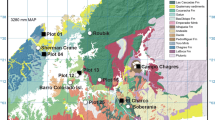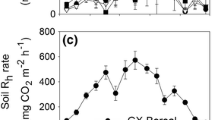Abstract
This study compares approximately weekly soil respiration across two forest–pasture pairs with similar soil, topography and climate to document how conversion of pasture to forest alters net soil CO2 respiration. Over the 2.5 year period of the study, we found that soil respiration was reduced by an average of 41% with conversion of pasture to forest on an annual basis. Both pastured sites showed similar annual soil respiration rates. Comparisons of the paired forests, one coniferous and the other broadleaf, only showed a significant difference over one annual cycle. Enhanced soil respiration in pastures may be the result of either enhanced root respiration and/or microbial respiration. Differences in pasture–forest soil respiration were primarily observed during the July through September summer period at all sites, suggesting that this is the critical period for observing and documenting differences. Evaluation of the soil microclimatic controls on soil respiration suggest that soil temperature exerts a major control on this process, and that examining these relationships on a seasonal rather than weekly basis provides the strongest relationships in poorly drained soils. Consistently greater pastured site Q 10s (2.52;2.42) than forested site Q 10s (2.27; 2.17) were observed, with paired-site differences of 0.25.





Similar content being viewed by others
References
Atkin OK, Bruhn D, Hurry VM, Tjoelker MG (2005) The hot and the cold unravelling the variable response of plant respiration to temperature. Funct Plant Biol 32:87–105
Beltrami H (2001) On the relationship between ground temperature histories and meteorological records: a report on the Pomquet station.Global Planet Change 29:327–352
Beltrami H, Kellman L (2003) An examination of short and long-term air-ground temperature coupling. Global Planet Change 38:291–303
Boone RD, Nadelhoffer KJ, Canary JD, Kaye JP (1998) Roots exert a strong influence on the temperature sensitivity of soil respiration. Nature 396:570–572
Cann DB, Hilchey JD (1954) Soil survey of Antigonish County. Nova Scotia, Truro, Nova Scotia
Fahey TJ, Siccama TG, Driscoll CT, Likens GE, Campbell J, Johnson CE, Battles JJ, Aber JD, Cole JJ, Fisk MC, Groffman PM, Hamburg SP, Holmes RT, Schwarz PA, Yanai RD (2005) The Biogeochemistry of Carbon at Hubbard Brook. Biogeochemistry 775:109–176, doi:10.1007/s10533-004-6321-y
Gleason SM, Ewel KC (2002) Organic matter dynamics on the forest floor of a Micronesian mangrove forest: an investigation of species composition shifts. Biotropica 34(2):190–198
Hanson PJ, Edwards NT, Garten CT, Andrews JA (2000) Separating root and soil microbial contributions to soil respiration: a review of methods and observations. Biogeochemistry 48:115–146
Hogberg P, Nordgrem A, Buchmann N, Taylor AFS, Ekblad A, Hogberg MN, Nyberg G, Ottosson-Lofvenius M, Read DJ (2001) Large-scale woodland girdling shows that current photosysnthesis drives soil respiration. Nature 411:789–792
IPCC TAR (Intergovernmental Panel on Climate Change, Third Assessment Report). In: Houghton JT, Ding Y, Griggs DJ, Noguer M, van der Linden PJ, Dai X, Maskell K, Johnson CA (eds) Climate Change 2001: The Scientific Basis. Cambridge Univ. Press, 2001
Johnson RS (1986) Forests of Nova Scotia. Four East Publications. Halifax NS, Canada
Kirschbaum MUF (2000) Will changes in soil organic carbon act as a positive or negative feedback on global warming? Biogeochemistry 48:21–51
Kaye JP, Hart SC (1998) Restoration of canopy type effects on soil respiration in a Ponderosa pine-bunch grass system. Soil Sci Soc Am J 62:1062–1072
Lavigne MB, Boutin R, Foster RJ, Goodine G, Bernier PY, Robitaille G (2003) Soil respiration responses to temperature are controlled more by roots than by decomposition in balsam fir ecosystems. Can J For Res 33(9):1744–1753
Ollinger SV., Smith ML.,Martin ME., Hallett RA.,Goodale CL.,Aber JD (2002) Regional variation in foliar chemistry and N cycling among forests of diverse history and composition. Ecology 83(2): 339–355
Raich JW, Schlesinger WH (1992) The global carbon dioxide flux in soil respiration and its relationship to vegetation and climate Tellus 44b:81–99
Raich J, Tufekcioglu A (2000) Vegetation and soil respiration correlations and controls. Biogeochemistry 48:71–90
Risk D, Kellman L, Beltrami H (2002a) Carbon dioxide in soil profiles: production and temperature dependency. Geophys Res Lett 29(6):1087, doi:10.1029/2001GL014002
Risk D, Kellman L, Beltrami H (2002b) Soil CO 2 production and surface flux at four climate observatories in eastern Canada. Global Biogeochem Cycles 16(4):1122, doi:10.1029/2001GB001831
Russell AE, Cambardella CA, Ewel JJ, Parkina TB (2004) Species rotation and life-form diversity effects on soil carbon in experimental tropical ecosystems. Ecol Appl 14(1):47–60
Six J, Elliott ET, Paustian K (2000) Soil macroaggregate turnover and microaggregate formation a mechanism for C sequestration under no-tillage agriculture. Soil Biol Biochem 32(14):2099–2103
Smith D, Johnson L (2004) Vegetation-mediated changes in microclimate reduce soil respiration as woodland expand into grassland. Ecology 85:3348–3361
Acknowledgments
This research was supported by the Canadian Foundation for Climate and Atmospheric Sciences (CFCAS), the Natural Sciences and Engineering Research Council of Canada (NSERC), and the Atlantic Canada Opportunities Agency (ACOA). Amanda Diochon provided the vegetation site descriptions and many other members of the Environmental Sciences Research Centre at StFXU contributed to the collection and analysis of this data. The comments of reviewers are gratefully acknowledged.
Author information
Authors and Affiliations
Corresponding author
Rights and permissions
About this article
Cite this article
Kellman, L., Beltrami, H. & Risk, D. Changes in seasonal soil respiration with pasture conversion to forest in Atlantic Canada. Biogeochemistry 82, 101–109 (2007). https://doi.org/10.1007/s10533-006-9056-0
Received:
Accepted:
Published:
Issue Date:
DOI: https://doi.org/10.1007/s10533-006-9056-0




